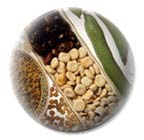- Home
- Introductions

|
Vegetable Seed Production
Cauliflower :: Chinese
Cabbage :: Radish :: Turnip
:: Rutabaga :: Mustard
Greens |
 |
Common Name: Cabbage,
Broccoli, Cauliflower, Brussels Sprouts, Collards, Kale, Kohlrabi Scientific Name: Brassica oleracea Family: Brassicaceae |
Introduction & history
Members of the family were formerly known as Cruciferae and are still called crucifers by some. This important family is comprised of nearly 300 genera including many important vegetable, field, and oil crops.
Cauliflower Seed Production and Identification page
 |
Common Name: Chinese
Cabbage Scientific Name: Chinensis group Family: Brassicaceae |
Chinese Cabbage introduction & history
Most Asian crucifers may be grouped into three general categories Chinese cabbage, Chinese broccoli and kale, and Asian mustard greens.
Chinese cabbage is the most widely grown Asian crucifer. Chinese cabbage can be classified as heading and nonheading types. A few of the common names used to describe heading types of Chinese cabbage include: nappa or napa, hakusai, pai-tsai, won bok, pechay, and tsina. Common names for nonheading types include: bok choy, pak choy, celery cabbage, celery mustard, chongee, petsay, and pei tsai. Head and nonheading types may be further classified according to head shape. Heading types are classified as open, erect or cylindrical, and ovoid or barrel. Common nonheading types form a flowering head on a fleshy stem, have an upright growth habit with prominent petioles, or form a rosette with short petioles.
Chinese Cabbage Seed Identification page
 |
Common Name: Radish Scientific Name: Raphanus sativus Family: Brassicaceae |
Radish introduction & history
Wild species are found in Europe eastward to the Volga River in Russia, and in the Mediterranean basin eastward to the Caspian Sea. Some taxonomists suggest the origin in further eastward, i.e., China. Most agree it is somewhere east of the Mediterranean.
Radishes were known to the Egyptians at least 2000 BC, in China 500 BC, Japan 700 AD, Germany 1400, England 1548, and Mexico 1500.
Radish Seed Identification page
 |
Common Name: Turnip Scientific Name: Brassica rapa (Rapifera group) Family: Brassicaceae |
Turnip introduction & history
Two main centers of origin have been indicated. The Mediterranean area is thought to be the primary center of the European forms, while eastern Afghanistan and Western Pakistan is considered to be another primary center. Secondary centers are Asia-Minor, Transcaucasus, and Iran.
Culture is ancient. Turnips were known to the Romans prior to Christian Era and grown in France about 2000 years ago. Turnips were brought to America by Cartier in 1541.
Turnips are important cool-season crops used as forage (both roots and tops) for livestock in addition to their use as human food throughout the world as vegetables.
Turnip Seed Identification page
 |
Common Name: Rutabaga Scientific Name: Brassica napus (Napobrasica group) Family: Brassicaceae |
Rutabaga introduction & history
It is uncertain whether or not B. napus exists in a truly wild form. If wild B. napus exists, it must be a European-Mediterranean species which originated in the area of the overlap between B. oleracea and the widely distributed B. campestris. Nonetheless, the domestication is recent. Known in England about 1600, earlier on the continent, and in the U.S. about 1800.
B. napus is a cool season (prefer temperatures less than 72 degrees F), frost tolerant biennial crop that is grown as an annual. The rutabaga has a rounded and/or elongated root that can become very large weighing 5 lbs or more each. Secondary roots arise from the underside of the enlarged root as well as from the tap root. The neck or crown is prominent. Leaves are smooth, bluish white, with thick petioles and covered with bloom.
Rutabaga Seed Identification page
 |
Common Name: Mustard
Greens Scientific Name: Brassica juncea Family: Brassicaceae |
Mustard Greens introduction & history
This is a nonheading crucifer crop, grown for leaves to be used in cooking or as a garnish or in salad bars.